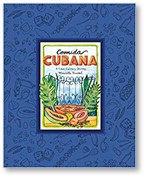Monday Author: Susanne Skinner
 Moving to a new location is more than changing houses and communities; it’s embracing a new culture. When we traded our beloved Northeast Cape Cod for tropical Southeast Cape Coral we jumped in to a lifestyle that includes new foods and places to try and buy them.
Moving to a new location is more than changing houses and communities; it’s embracing a new culture. When we traded our beloved Northeast Cape Cod for tropical Southeast Cape Coral we jumped in to a lifestyle that includes new foods and places to try and buy them.
Tropical weather is one of the big reasons we made the move. But it also means a never-ending growing season and many new culinary experiences. In between unpacking and working we’ve made it our mission to explore the eateries and grocery stores; and in the process I am discovering the Florida Kitchen.
We’ve encountered delicious food and found local shops that carry ethnic ingredients and the secrets to preparing them.
The Cuban Influence on the Florida Kitchen
Cape Coral is less than 500 miles from Cuba, which provides a tangible Latino influence on the local way of life. Our radius for eating and shopping includes a great Latino market and lots of family-owned bistros.
The Cuban inspiration on the Florida kitchen is a hot and spicy one, but it’s not without its sweet side. There is a Cuban bakery near us that does not disappoint! Cuban bread is the equivalent of the traditional Italian loaf in our old stomping grounds, and the essential starting point for the Cuban sandwich we’ve come to enjoy. The sandwiches are big enough for two, and filled with well-seasoned, slow-simmered pork.
 Café Cubano or Cuban coffee is something to love. Growing up and working in Europe honed my coffee snob attitude. At home we grind our beans and favor the dark roasts. I drink it black, but make an exception when it comes to café Cubano.
Café Cubano or Cuban coffee is something to love. Growing up and working in Europe honed my coffee snob attitude. At home we grind our beans and favor the dark roasts. I drink it black, but make an exception when it comes to café Cubano.
Cuban coffee is strong. It starts with strong bitter espresso and is balanced by something called espuma—a film layered on the top of the coffee that involves pouring a few drops of espresso into a small amount of sugar and whipping it into a light froth. It gives the coffee a smooth finish and the drinker a big energy boost! Café Bustelo is the bean of choice, available in most markets.
Cuban Pastry and Sauces
Cuban pastry is also worthy. Made from puff pastry and filled with sweet cream cheese guava, pineapple or coconut, they are the perfect accompaniment to that energizing shot of coffee.
Chimichurri sauce originates from Argentina but can be found as an accompaniment in most Cuban restaurants. It’s a fresh oil-based sauce that adds a wonderful dimension of flavor to churrasco, or grilled meat. Restaurants here are mostly family owned, and have their own house-made recipe for this sauce.
Florida Seafood
One of the first lessons I learned in the Florida kitchen is that not all shrimp are alike. Down here there are many different kinds, but the most abundant is the pink shrimp, or Key West Pinks, which are sweeter and more tender than other varieties. You can tell it’s the real deal by the pink dot in the middle of the shell. A popular way to enjoy them is the Key West Shrimp Boil with homemade key lime mustard. Key limes are everywhere and very inexpensive.
I have always loved grouper, a member of the sea bass family, but it’s not native to New England waters. Florida harvests over 85% of all grouper caught, and down here you can get it directly off the boat. The fish is lean, with very little fishy taste and a meaty texture. It’s best when lightly seasoned and broiled, like this lemon-and-thyme recipe, or cooked with the traditional cracker-crumb coating and a fresh squeeze of lemon.
Southern Traditions
Speaking of key limes, the key lime pie is just about everywhere. But not all pies are created equal, and I try to avoid overly sweetened versions. A key lime pie needs the key lime to be authentic. They are also known as Mexican or West Indian limes, and are slightly yellow in color, more tart and aromatic, with a juice that is more floral. A true key lime pie is not green.
 For my palate, the authentic recipe needs a buttery graham-cracker crust, not the traditional pastry crust. I also prefer a meringue topping to whipped cream.
For my palate, the authentic recipe needs a buttery graham-cracker crust, not the traditional pastry crust. I also prefer a meringue topping to whipped cream.
Sweet tea is the drink of choice and I confess I love it. Authentic sweet tea has a secret ingredient for keeping the beverage clear and crisp—the addition of a pinch of baking soda. It also keeps it from tasting bitter and there is nothing more refreshing on a hot day.
Mangos Everywhere
The mango is Florida’s version of the abundant zucchini most northern gardeners produce. They are everywhere and free if your neighbors have a tree. Our new yard not only boasts a mango tree, but lemon, lime and avocado trees. Boxes filled with fruit can be found at the end of driveways, a church we visited offered free mangos during their coffee hour and every grocery store sells them.
I’ve learned to make mango bread by pureeing the fruit and it’s freezer friendly. Mango salsa and mango chutney blend the sweetness of the fruit with other flavors and can be used as an accompaniment to grilled meats.
Eating Differently in the Florida Kitchen
Hot weather means lighter fare in the Florida kitchen and weekend farmers markets. The one near us includes offerings from a German bakery, a pickle vendor, farm-fresh eggs and multiple purveyors of jams, jellies and sauces. Samples are always available, and many a new item has found its way home after a taste or two.
We have a lot more to explore and experience but my Florida kitchen is shaping up nicely,
